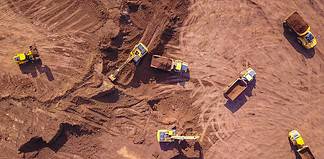WHILE the recent Noosa Mining Conference in Queensland was abuzz with investors considering their options, there was a notable difference in sentiment towards larger companies as opposed to juniors.
Keynote speaker Lion Selection executive director Hedley Widdup said investor sentiment had been low towards juniors since 2018.
“In 2018 something broke. It is very difficult to raise money in the junior sector at the moment,” Mr Widdup said.
“Investors are not only not buying, they are also selling, so there has been a wholesale movement away from the junior space.”
Mr Widdup puts this partially down to the fact that being pre-production means juniors are harder to value which makes them hard to price – so why wouldn’t investors jump on something like BHP, a big company with a solid performance record.
“If you’re not a miner, it’s very difficult to value you, and you get priced according to a range of risks and this is where the breakdown starts to occur,” he said.
“Because the business model of someone who is not a miner is to try and create value – and you’re not creating it every day by digging up a tonne, putting it through a mill and then selling it for the money at the end – you are envisaging how that’s going to take place.
“They [investors] don’t like permitting, they don’t really like commissioning but they particularly don’t like funding because you can’t see what’s on the other side of that risk and the easiest way to manage that risk is by avoidance.”
As to where investors are spending their money, the tech and cannabis market are to blame.
In 2009 there were around 20 unlisted companies with a market capitalisation of a billion dollars, but today, there are more than 150 – plus there is the legalised medicinal marijuana market in North America.
“On the Toronto Stock Exchange (TSX) and the TSX Venture Exchange (TSXV) in 2016, 2017, and 2018, the amount of money raised by miners went from about $9 billion to $8.5b to $6.4b,” Mr Hedley said.
“The amount of money raised by pot companies on the same exchanges went from $1.3b to $3.5b to $9b – so it’s captured that money that’s been going into mining companies each year.
“But the interesting thing is that the miners that sit on the Canadian exchanges account for around 15pc of the market and pot stocks account for around 1-2pc, so it’s a huge amount of money trying to push its way into a tiny space, and of course the equity returns are eye-watering, which only attracts more money.”
While Mr Hedley doesn’t advise miners go green or become pot companies, he does advise patience.
“There has not been a bubble in any industry on earth that hasn’t eventually popped so I don’t think these things will persevere for too long,” he said.
“But of course it’s very frustrating as the managing director of a junior company to sit and wait for that to happen.”
Mr Hedley said gold could be the catalyst to bring the equity market to its senses, with some of the biggest gold deals happening during the last three years, such as Barrick Randgold and the Newmont Goldcorp merger.
“These big companies with big cash flows and balance sheets are not only looking at each other, they’re also investing in juniors, they’re spending money,” Mr Hedley said.
“And this is the loudest and clearest signal that they could be sending to the market to say we want to grow, we see value here and we’re putting money into these companies.
“From the point of view of investors, the red light is on, they’re sitting there revving their engine, paying attention, looking for a change, but they’re not doing anything and that’s why it’s hard to raise cash at the moment.
Mr Hedley said his gut was telling him that, with the industry buying and commodity trends, the signal could be about to go green.








































